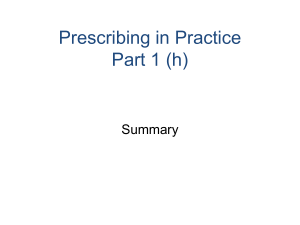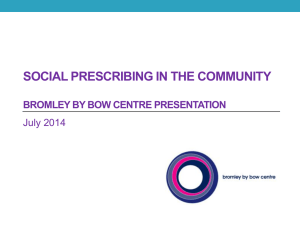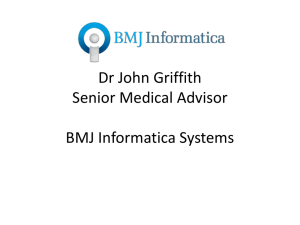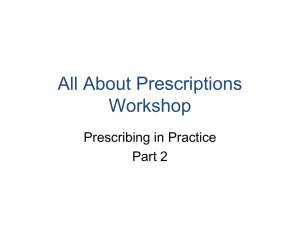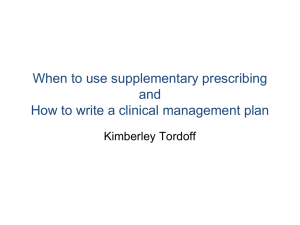Prescribing Triangle
advertisement
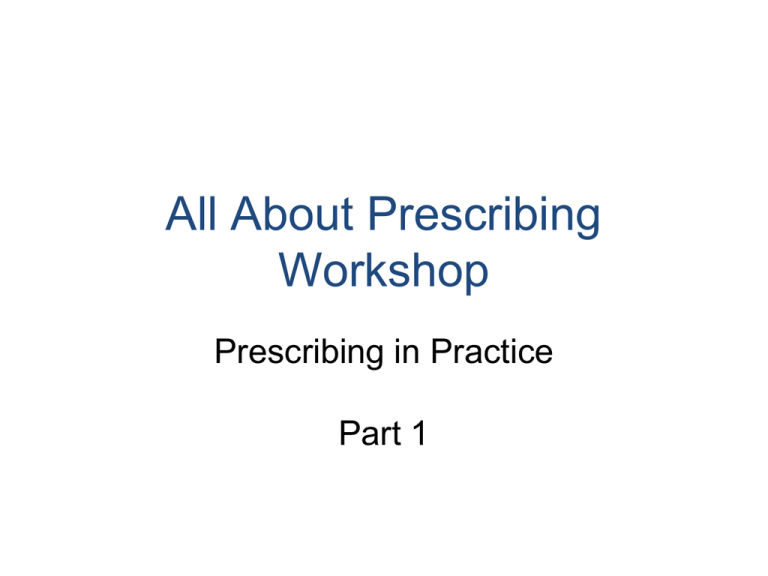
All About Prescribing Workshop Prescribing in Practice Part 1 Learning Objectives • To understand the principles of good prescribing • To be aware of the legal requirements of a prescription • To be aware of good standards of practice • To be aware of the importance of preventing fraud • To discuss how they prospective prescriber feels about prescribing Facts • More nurses have been sent on nurse prescribing courses than are currently prescribing • Latter et al (2010) found that 93% of nurse prescribers & 80% of pharmacy prescribers were using their Independent Prescribing qualification. • Evidence suggests that acceptability of NMPs is acceptability to patients is high and viewed positively by other HCPs (Latter et al, 2010). Prescribing errors • Those occurring in the decision making process e.g. wrong drug, dose, strength • Those occurring during the prescription writing process e.g. illegible prescriptions, inaccurate transcriptions or poor communication • Hospital prescribing errors occur in the range of 0.56 to 9.9% of all prescriptions Dean et al (2002) and community 4.35 to 10.2% Why do errors occur? • • • • • Unintentional slips, Omissions Illegible prescriptions Inaccurate transcription Positioning of zero and decimal points causing tenfold errors • DISTRACTION Dean (2002) showed that doctors did not regard the task of prescribing as important. Computer generated prescriptions • All prescriptions include drug name, dose, frequency due to prompts • Legible • Information about patient is there at time of prescribing • Information about the drug is there as well • Prescriptions are checked for drug interactions, and cautions • Great for audit/pharmacovigilance • Relevant prescribing details can be built into system Feelings • How do you feel about the prospect of prescribing? • How will prescribing benefit your practice? • What difficulties/conflicts might you encounter? The Law • The Medicines Act 1968 assures the quality safety and efficacy of medicines as well as maintain the safety of the public by controlling routes of access • The Misuse of Drugs Act 1971 adds an additional layer of tougher supply controls for drugs with a high potential of abuse Licensing Why is this important? • Greater control and safety needed • Marketing Authorisation (MA) (formerly Product Licence) granted by MHRA once they are satisfied of the safety, quality and efficacy of a drug. • This process may take many years • The drug is then licensed • The MA states the indications and contra indications & age range for the drugs use Off Label / Off Licence • You as a prescriber must be very aware of the licence situation of all that you prescribe, because you are liable (or your employer is) if harm is proven following an off label prescription • Such prescribing is common in paediatrics, palliative care • Is there anything in your practice that you will be prescribing off label? Categories of medicines under Medicines Act (1968) Category General sales list (GSL) Restrictions on availability Paracetamol 500mg tabs (16) They must be sold in original package, there may be limits on pack size and must be sold from permanent premises e.g. garage Pharmacy medicines (P) Can only be sold from a registered pharmacy under the supervision of a pharmacist who can refuse the sale Paracetamol 500mg tabs (32) Prescription only medicine (POM) Paracetamol 1g qds 100 tabs Can only be supplied or authorised for supply by an appropriate practitioner Controlled Drugs • Misuse of Drugs Act 1971 aims to prevent the misuse of drugs that are ‘dangerous and harmful’ • They are grouped in Schedules 1-5 • 1 no medicinal use ecstasy, LSD • 2 around 100 substances mainly opiates • 3 barbiturates, temazepam, buprenorphine • 4 split into benzodiazepines and anabolic/growth hormones • 5 preparations of certain CDs pholcodeine, codeine Controlled drugs (CDs) • Nurse / midwife independent prescriber are restricted to prescribe only certain CDs solely for specific medical conditions if this falls within their scope of practice • A nurse/midwife or Allied Health Professional supplementary prescriber can prescribe any schedule 2-5 CD for any condition within their competence as part of a patient specific, written clinical management plan agreed with the Dr & the patient Controlled Drugs See Department of Health, Nurse Prescribing Frequently Asked Questions www.dh.org.uk (accessed 3/8/11) Facilitator’s note: ensure up to date list of Controlled Drugs is used see www.dh.org.uk or Home Office website www. homeoffice.gov.uk Controlled Drugs Legislation- Nurse prescribing and patient group directions for details Appropriate Practitioners Originally there were only three • A doctor • A dentist • A vet Since non medical prescribing more have been added • A community nurse practitioner • A nurse independent practitioner • A pharmacist & optometrist independent practitioner • A supplementary prescriber (nurses, physiotherapists, podiatrists, radiographers) NHS Regulations (see MHRA) • Blacklist-a list of substances that are not to be prescribed under NHS pharmaceutical services. If one is prescribed and the pharmacist dispenses it he will not be reimbursed e.g. Otrivine nasal spray • Borderline substances-substances that the NHS consider to be less suitable for prescribing and will only pay for if the Advisory Committee on borderline substances approves that they are regarded as drugs e.g. specialised enteral feeds or supplements • Black triangle-a newly licensed drug that is being intensively monitored ADR reporting important e.g. fluticasone furoate nasal spray Who can prescribe what? ‘Independent prescribing is prescribing by a practitioner responsible and accountable for the assessment of patients with diagnosed or undiagnosed conditions and for decisions about the clinical management required, including prescribing’ (DH 2006) Limitations • May not prescribe blacklisted drugs • May only prescribe CDs in certain circumstances Legislation on prescriptions • To be legally valid, prescriptions must comply with regulations made under the Medicines Act. • If an invalid prescription is filled the pharmacist has committed a criminal offence Prescription Writing Legal Requirements Good Practice • Your professional body standards on prescribing/codes of conduct • Local guidelines • BNF guidelines • DH guidelines Legal requirements • Name and address of patient • Signature in ink by the prescriber • The practice address/address of prescriber • The date it was written or date intended • Information on who the prescriber is (Dr, dentist, IP, SP) • The age of the patient if under 12 years of age • There are additional requirements for Validity • Valid for 6 months from the date of prescription • Prescriptions for CDs in schedule 2 & 3 are valid for 13 weeks/28 days Good Clinical Practice • • • • • • • Written legibly DOB included Dosage instructions clear Frequency Formulation Quantity The route (N.B.) Must dos See BNF for legal and good practice in prescription writing BNF gives you very clear directions to be followed Can do • Cautionary and advisory labels…last page of BNF – Label 29 & 30…’Do not take more than 2 at a time and more than 8 in 24 hours’, ‘Do not take with any other paracetamol products’ Accountability • Vicarious liability • Professional accountability Responsibility • The practitioner can only prescribe for a patient who they have assessed. • Community practitioners may only prescribe on her own personal prescription pad. • In the absence of the patient’s original assessor who has initiated the first prescription the community nurse may write a repeat prescription or order repeat doses in order to preserve continuity of care. • All prescribers have a responsibility to report suspected adverse drug reactions ADRs • Only prescribe when there is a need to prescribe • If patient is pregnant or breast feeding only prescribe if absolutely necessary • Always establish if the patient has allergies or previous reactions to medications • Establish if the patient is taking any other medications • Consider age, renal and hepatic function • Prescribe as few drugs as possible and start low and go slow if appropriate • Only prescribe drugs you are familiar with • Inform the patient of potential reactions • • • • • • • • • • • Record Keeping (e.g. NMC, 2010) Accurate Legible (handwriting) Unambiguous Contemporaneous Relevant Sufficient Dated, timed and signed Signature printed alongside signature Date prescription written Name & profession of prescriber & if IP/SP Name of drug, dose, route, formulation, duration (See Principle 7 NMC 2010) Record Keeping • The record of the prescription should be entered into the nursing notes and medical records at the time of writing the script or as soon as practically possible thereafter at the very latest within 48 hours or by local arrangement. (Standards as in NMC (2010) Record Keeping Guidelines apply) • Sometimes it might be necessary to inform another member of the team that a prescription has been issued. In this case that action should be recorded in the nursing notes. Family and Friends As a non medical prescriber are you allowed to prescribe for family and friends? Blood and Blood Products • As an IP can you prescribe Blood? • Blood, packed cells and platelets cannot be prescribed by an IP as they are not considered to be a medicinal product and are so outside the gambit of the Medicines Act (1968) • What about derived blood products such as clotting factors, antibodies and albumin? • These are considered medicinal products Fraud • • • • Keep secure Treat like cheques and NEVER pre sign Extra care in community NHSBSA recommendations – Should not be left unattended at reception desks – Should not be left visible in a car – When not in use they should be in a locked drawer within the surgery & at home Prescribing in practice • Visualise how you will prescribe for the patients in your area, this will help you integrate skills and knowledge • This forward thinking will help prepare you for when your practice begins • Are there any logistical problems that you anticipate? Practical • Write a couple of prescriptions for drugs that you will be writing in practice. • Swap them with your neighbour and go through the checklist to see if they are correct Check List Clearly written in ink Name and address of patient NHS Number Date of Birth Age if under 12 years Name of drug Amount of drug in correct units Route of administration Frequency of administration Quantity to supply Number of days treatment Signed and dated As required drugs should have minimum dosing interval Only use abbreviations listed Check dose etc appropriate in BNF Summary • Before you prescribe it is important to consider the prescribing triangle and principles of good prescribing • Refer to BNF and NMC standards for legal requirements • Be aware of potential for fraud Security of prescriptions • Is the responsibility of the employing organisation and the prescriber • Hold only minimal stocks of pads in order to minimise the impact in case of loss or theft • This also helps when forms are reviewed annually to avoid waste Serial numbers and loss of pads • Should be recorded by the employer before issue to the nurse • Recorded by the nurse to aid identification in case of theft • Astron should be contacted if there is loss, or ordered pads do not arrive • NHBSA notified if they are not found • Inform prescribing lead who will contact counter fraud specialist at the PCT • They will alert pharmacists and the prescriber will use a different coloured pad until the matter is resolved Getting your prescriptions • After completing the course and qualifying as a IP/SP Prescriber the NMC/HPC/RPSGB will be informed by the university and will then annotate the register to indicate that the NMP can prescribe as either an IP/SP or SP using the BNF. ( This is different from the HV/DN annotation V100) • The University will also inform the prescribing leads of successful course completion. • Employers can check professional register to confirm prescribing status Getting started • PRESCRIPTION PADS ARE NOT SENT OUT AUTOMATICALLY. • FP10 s need to be ordered from the supplier (currently ASTRON) Orders cannot be placed with ASTRON until the NHSBSA have been notified of the new nurse prescribers details. • ASTRON will not issue prescriptions unless the NHSBSA details match those given by the organisation requesting Action for employers • The employer (PCT Prescribing Lead) will then inform the NHS Business Services Authority (NHSBSA) of the Nurse/AHP Prescribers details using the proforma available on the NHSBSA website: http://www.nhsbsa.nhs.uk/ (Note hospital based nurses/AHPs do not need to inform the NHSBSA) Stock items Items should be prescribed for individual patient use Over prescribing to stock up the nurses own supplies is illegal. Security of Prescriptions • The security of Prescription forms is the responsibility of the Employing Organisation and the Nurse Prescriber. • It is advisable to only hold minimal stocks of prescription forms in order to minimise loss in the case of theft or break in, and also helps keep prescription forms up to date. (normally reviewed annually) Serial Numbers • Should be recorded by the employer before issue to the nurse. • Recorded by the nurse to aid identification in the case of theft. • Blank prescriptions should NEVER be presigned. Loss of prescription pads • ASTRON should be contacted about prescriptions ordered but not received. • NHSBSA should be notified if they are not found. • Community prescribers should inform the local counter fraud specialist at the PCT, their manager and the Prescribing Nurse Lead, if they loose or have prescription pads stolen. References cont. Latter, S, Blenkinsopp, A, Smith, A, Chapman, S, Tinelli, M, Gerard, K, Little, P, Celino, N, Granby T, Nicolls, P and Dorer G (2010) Evaluation of Nurse and Pharmcist Independent Prescribing University of Southampton and Keele University available at http://eprints.soton.ac.uk/184777/3/ENPIPfullreport.pdf Medicines and Health care products regulatory agency ww.mhra.gov.uk Misuse of Drugs Act 1971 www.legislation.gov.uk Midwifery Council (NMC) (2010) Record Keeping guidelines www.nmc.org.uk NHS Business Services Authority www.nhsbsa.nhs.uk The Medicines Act 1968 www.legislation.gov.uk References British National Formulary (BNF) www.bnf.org.uk Cavell GE, and Hughes DK (1997) Does computerised prescribing improve the accuracy of drug administration? Pharmaceutical Journal vol 259, pp782-84 Dean, BS, Schachter M, Vincent, C and Barber ND (2002) Prescribing errors hospital inpatients: their incidence and clinical significance, Quality and Safety in Healthcare December vol 11(4) pp 340-44 Department of Health (DH) (2006) Nurse Independent Prescribing www.dh.org.uk Department of Health (DH) (2011) Nurse Prescribing Frequently Asked Questions www.dh.org.uk (accessed 3/8/11 Further reading Medicinal products: prescription by nurse and others Act 1992 www.legislation.go.uk Useful websites Royal Pharmaceutical Society of Great Britain (RPSGB) www.rpharms.com Health Professions Council (HPC) www.hpcuk.org This work was produced as part of the TIGER project and funded by JISC and the HEA in 2011. For further information see: http://www.northampton.ac.uk/tiger. This work by TIGER Project is licensed under a Creative Commons Attribution-NonCommercial-ShareAlike 3.0 Unported License. Based on a work at tiger.library.dmu.ac.uk. The TIGER project has sought to ensure content of the materials comply with a CC BY NC SA licence. Some material links to third party sites and may use a different licence, please check before using. The TIGER project nor any of its partners endorse these sites and cannot be held responsible for their content. Any logos or trademarks in the resource are exclusive property of their owners and their appearance is not an endorsement by the TIGER project.
